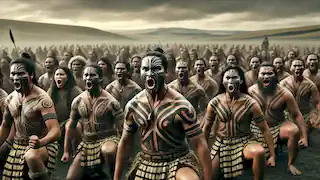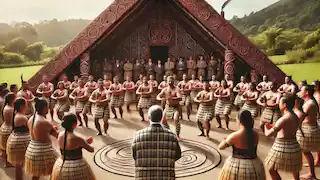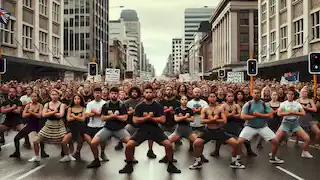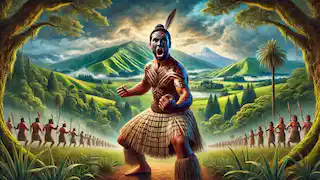In the heart of Aotearoa, now known as New Zealand, lies the story of one of the most powerful and evocative cultural expressions of the Māori people – the haka. This ancient war dance, more than just a display of fierce movements and loud chants, carries within it the spirit, history, and mana (prestige) of the Māori. The haka’s journey through time tells a tale of pride, connection, challenge, and the deep ties between the Māori people and the land they call home. To truly understand the haka, one must delve into its origins, its role in warfare and ceremony, and its enduring presence in modern times.
The story begins long before the arrival of European settlers in New Zealand, in a time when Māori tribes, known as iwi, roamed the islands, and their way of life was deeply connected to the land, the sea, and the stars. The origins of the haka can be traced back to the legendary demigod Tūmatauenga, the god of war, humans, and conflict. In Māori cosmology, Tūmatauenga was the fierce warrior who stood against his brothers during a time of division among the gods. His brothers, Tāwhirimātea (god of storms and winds), Rongo (god of peace and cultivated food), Tangaroa (god of the sea), and others, each had their own domains of power. But it was Tūmatauenga who, when provoked, prepared for battle with a haka—a war dance that called upon his courage, strength, and defiance. The haka of Tūmatauenga was not just about intimidating his enemies but also about invoking his ancestors' spirit, connecting himself to the gods, and preparing mentally and spiritually for the challenges ahead. This divine connection meant that haka was more than just physical preparation; it was a sacred ritual, imbued with the mana of generations. As the Māori people developed their own war dances, they carried the traditions of their gods. These war dances were used to prepare for battle, to challenge rivals, and to honor the ancestors and gods before them. The haka became a symbol of defiance and unity, a way to express their emotions before engaging in life-threatening combat. Different tribes developed their own haka, each unique in style, movement, and meaning. However, all shared the core purpose: to stir the spirit, strengthen the heart, and remind the people of their purpose and connection to the sacred. Māori society was built around tribes and sub-tribes, each with their own territories, warriors, and customs. Conflict was a constant threat in early Māori society, and war was often waged to defend tribal lands, avenge wrongs, or assert dominance. Before warriors took to the battlefield, they would perform the haka. The haka served several purposes in battle. Firstly, it was a form of psychological warfare. Māori warriors would stand in formation, their faces painted with moko (tribal tattoos), and perform a fearsome haka. With their voices booming, eyes wide with intensity, and bodies pulsating in unison, the warriors aimed to terrify their enemies. The haka declared their readiness for battle and their willingness to die for their tribe. Secondly, the haka was a way to unite the warriors. By chanting and moving as one, the group reinforced their sense of belonging, their shared purpose, and their resolve to protect one another. The unity felt during the haka gave them strength that went beyond individual capabilities—it created a collective force bound by honor and pride. Lastly, the haka was a form of spiritual protection. The chants often invoked the ancestors, calling upon their guidance and support in battle. The warriors believed that they were not alone, that the spirits of their ancestors were fighting alongside them, giving them courage and strength. One of the most famous Māori haka is "Ka Mate," composed by the chief Te Rauparaha of the Ngāti Toa tribe. Legend tells that Te Rauparaha was fleeing from enemies and sought refuge in a food pit. He chanted the words of "Ka Mate" when he emerged safely, celebrating his escape from death. The words, "Ka mate! Ka mate! Ka ora! Ka ora!" ("I die! I die! I live! I live!") encapsulated the fine line between life and death that the Māori warriors walked. Over time, the haka evolved beyond the battlefield. While its roots lay in war, the haka also became a way to honor important figures, celebrate victories, and mark significant events. When chiefs or other prominent figures visited a tribe, they would be greeted with a haka as a sign of respect and recognition of their mana. The haka would also be performed at funerals to honor the deceased, sending their spirit off with power and dignity. In Māori society, the haka was a way to express emotions that words alone could not convey. Whether celebrating life or mourning death, the haka was an outlet for the deepest feelings of the heart and soul. It was a way to channel grief, joy, anger, or pride into a collective expression that bonded the community together. The ceremonial haka was often less aggressive than the war haka, focusing instead on rhythm, precision, and grace. Women also played an important role in the ceremonial haka, especially in the welcoming dances. Although women rarely participated in the war haka, their presence was central to the ceremonial ones, emphasizing the inclusivity and unity that the haka fostered within the tribe. Today, the haka is known worldwide, thanks in large part to the New Zealand All Blacks rugby team, who have performed "Ka Mate" before international matches since 1905. For the All Blacks, the haka is a way to honor their heritage, assert their pride as New Zealanders, and intimidate their opponents. While many associate the haka with rugby, its cultural significance goes far beyond the sporting world. For the Māori people, the haka remains a vital expression of their identity, culture, and connection to their ancestors. It is performed at weddings, funerals, graduations, and other significant events. The haka is still used to welcome visitors to a marae (tribal meeting grounds), as it has been for centuries. In recent years, the Māori have also used the haka as a form of protest and activism. By performing the haka at political rallies, protests, or in response to perceived injustices, the Māori people demonstrate their resolve, unity, and defiance. The haka’s power as a tool for expressing strength, emotion, and resistance remains as strong today as it was in the past. One of the most memorable modern haka performances occurred in 2019, when the Māori people performed the haka in response to the Christchurch mosque attacks. The haka was used to show solidarity with the Muslim community, express grief, and channel the collective mourning of the nation. It was a powerful reminder of the haka’s ability to unite people and express emotions that words cannot. As we move into the future, the haka continues to evolve. Māori youth are embracing their cultural heritage, learning the haka, and performing it with pride. Schools across New Zealand teach the haka, ensuring that future generations carry on this powerful tradition. Beyond New Zealand’s shores, the haka has also found a home. In sports, international events, and cultural festivals, the haka is performed as a symbol of New Zealand’s unique identity. However, there are ongoing discussions about the appropriation of the haka, as some worry that its cultural significance may be diluted when performed outside of its traditional context. To preserve the mana of the haka, it is crucial to respect its origins and the cultural context in which it exists. The haka is not just a performance but a spiritual and cultural expression deeply tied to the Māori people’s history and identity. For those who are not Māori, learning and performing the haka should be done with respect and understanding of its significance. The haka is a living tradition, one that carries the weight of centuries of history but also adapts to the needs and expressions of the modern world. As long as the Māori people continue to cherish their culture, the haka will remain a symbol of pride, unity, and defiance, inspiring generations to come. The haka, born from the stories of gods and the trials of war, is a testament to the strength, spirit, and resilience of the Māori people. It is an expression that transcends time, uniting past and present, the living and the dead, the sacred and the earthly. It embodies the pride of a people and their connection to their ancestors and the land. For the Māori, the haka is not just a dance but a way of life, a way to express emotions, celebrate triumphs, and face challenges with dignity and strength. The rest of the world has come to recognize the haka as a symbol of New Zealand’s identity, but for the Māori, it is much more—it is the heartbeat of their nation, pulsing with the mana of generations past, present, and future.The Origins of the Haka

The Haka in Warfare
The Ceremonial Haka
The Modern Haka

The Haka of the Future

Conclusion – The Heartbeat of a Nation


















